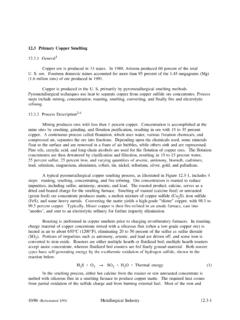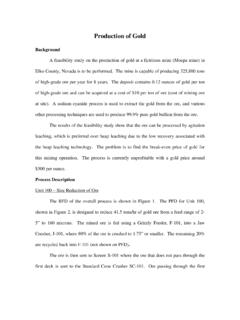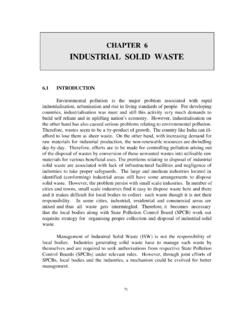Transcription of 11.6 Portland Cement Manufacturing
1 Portland Cement Process Description1-7 Portland Cement is a fine powder, gray or white in color, that consists of a mixture ofhydraulic Cement materials comprising primarily calcium silicates, aluminates and than 30 raw materials are known to be used in the manufacture of Portland Cement , and thesematerials can be divided into four distinct categories: calcareous, siliceous, argillaceous, andferrifrous. These materials are chemically combined through pyroprocessing and subjected tosubsequent mechanical processing operations to form gray and white Portland Cement . Gray portlandcement is used for structural applications and is the more common type of Cement produced.
2 Whiteportland Cement has lower iron and manganese contents than gray Portland Cement and is usedprimarily for decorative purposes. Portland Cement Manufacturing plants are part of hydraulic cementmanufacturing, which also includes natural, masonry, and pozzolanic Cement . The six-digit SourceClassification Code (SCC) for Portland Cement plants with wet process kilns is 3-05-006, and thesix-digit SCC for plants with dry process kilns is Cement accounts for 95 percent of the hydraulic Cement production in the UnitedStates. The balance of domestic Cement production is primarily masonry Cement . Both of thesematerials are produced in Portland Cement Manufacturing plants.
3 A diagram of the process, whichencompasses production of both Portland and masonry Cement , is shown in Figure As shownin the figure, the process can be divided into the following primary components: raw materialsacquisition and handling, kiln feed preparation, pyroprocessing, and finished Cement grinding. Each ofthese process components is described briefly below. The primary focus of this discussion is onpyroprocessing operations, which constitute the core of a Portland Cement initial production step in Portland Cement Manufacturing is raw materials , the element of highest concentration in Portland Cement , is obtained from a variety ofcalcareous raw materials, including limestone, chalk, marl, sea shells, aragonite, and an impurelimestone known as "natural Cement rock".
4 Typically, these raw materials are obtained from open-facequarries, but underground mines or dredging operations are also used. Raw materials vary fromfacility to facility. Some quarries produce relatively pure limestone that requires the use of additionalraw materials to provide the correct chemical blend in the raw mix. In other quarries, all or part ofthe noncalcarious constituents are found naturally in the limestone. Occasionally, pockets of pyrite,which can significantly increase emissions of sulfur dioxide (SO2), are found in deposits of limestone,clays, and shales used as raw materials for Portland Cement . Because a large fraction (approximatelyone third) of the mass of this primary material is lost as carbon dioxide (CO2) in the kiln, portlandcement plants are located close to a calcareous raw material source whenever possible.
5 Other elementsincluded in the raw mix are silicon, aluminum, and iron. These materials are obtained from ores andminerals such as sand, shale, clay, and iron ore. Again, these materials are most commonly fromopen-pit quarries or mines, but they may be dredged or excavated from underwater gypsum or natural anhydrite, both of which are forms of calcium sulfate, is introducedto the process during the finish grinding operations described below. These materials, also excavatedfrom quarries or mines, are generally purchased from an external source, rather than obtained directlyfrom a captive operation by the Cement plant. The Portland Cement Manufacturing industry is relyingincreasingly on replacing virgin materials with waste materials or byproducts from other manufacturing1/95 Mineral Products Process flow diagram for Portland Cement Manufacturing .
6 (SCC = Source Classification Code.) FACTORS1/95operations, to the extent that such replacement can be implemented without adversely affecting plantoperations, product quality or the environment. Materials that have been used include fly ash, millscale, and metal smelting second step in Portland Cement manufacture is preparing the raw mix, or kiln feed, for thepyroprocessing operation. Raw material preparation includes a variety of blending and sizingoperations that are designed to provide a feed with appropriate chemical and physical properties. Theraw material processing operations differ somewhat for wet and dry processes, as described raw materials are received with an initial moisture content varying from 1 to morethan 50 percent.
7 If the facility uses dry process kilns, this moisture is usually reduced to less than1 percent before or during grinding. Drying alone can be accomplished in impact dryers, drum dryers,paddle-equipped rapid dryers, air separators, or autogenous mills. However, drying can also beaccomplished during grinding in ball-and-tube mills or roller mills. While thermal energy for dryingcan be supplied by exhaust gases from separate, direct-fired coal, oil, or gas burners, the most efficientand widely used source of heat for drying is the hot exit gases from the pyroprocessing transport associated with dry raw milling systems can be accomplished by a varietyof mechanisms, including screw conveyors, belt conveyors, drag conveyors, bucket elevators, air slideconveyors, and pneumatic conveying systems.
8 The dry raw mix is pneumatically blended and storedin specially constructed silos until it is fed to the pyroprocessing the wet process, water is added to the raw mill during the grinding of the raw materials inball or tube mills, thereby producing a pumpable slurry, or slip, of approximately 65 percent slurry is agitated, blended, and stored in various kinds and sizes of cylindrical tanks or slurrybasins until it is fed to the pyroprocessing heart of the Portland Cement Manufacturing process is the pyroprocessing system. Thissystem transforms the raw mix into clinkers, which are gray, glass-hard, spherically shaped nodulesthat range from to centimeters (cm) ( to inches [in.)]
9 ]) in diameter. The chemicalreactions and physical processes that constitute the transformation are quite complex, but they can beviewed conceptually as the following sequential events:1. Evaporation of free water;2. Evolution of combined water in the argillaceous components;3. Calcination of the calcium carbonate (CaCO3) to calcium oxide (CaO);4. Reaction of CaO with silica to form dicalcium silicate;5. Reaction of CaO with the aluminum and iron-bearing constituents to form the liquidphase;6. Formation of the clinker nodules;7. Evaporation of volatile constituents (e. g., sodium, potassium, chlorides, and sulfates);and8.
10 Reaction of excess CaO with dicalcium silicate to form tricalcium Products sequence of events may be conveniently divided into four stages, as a function of locationand temperature of the materials in the rotary Evaporation of uncombined water from raw materials, as material temperature increases to100 C (212 F);2. Dehydration, as the material temperature increases from 100 C to approximately 430 C(800 F) to form oxides of silicon, aluminum, and iron;3. Calcination, during which carbon dioxide (CO2) is evolved, between 900 C (1650 F) and982 C (1800 F), to form CaO; and4. Reaction, of the oxides in the burning zone of the rotary kiln, to form Cement clinker attemperatures of approximately 1510 C (2750 F).



















